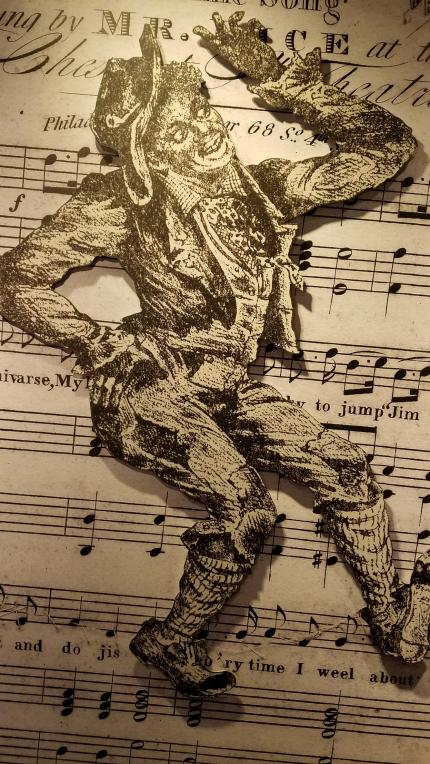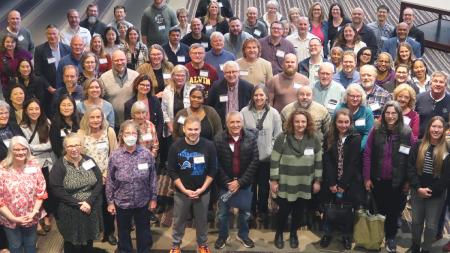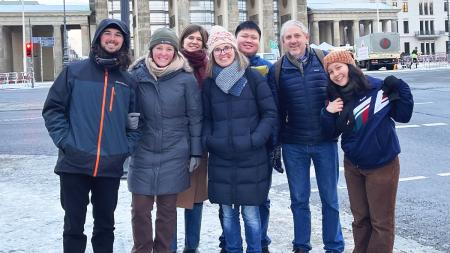Reflecting on 'Mammy' Salt and Pepper Shakers and Jim Crow

Chris Meehan
A couple of days ago, I sat with others in a room called “Cloud of Witnesses.” We had just been through the Jim Crow Museum on the campus of Ferris State University in Big Rapids, Mich. In the “Cloud of Witnesses” room, we shared our reactions to the photos, videos, and artifacts that we had seen.
The visit was sponsored in part by Congregations Organizing for Racial Reconciliation (CORR). Among other things, CORR puts on antiracism training for CRC congregations and various organizations. It also arranges for experiences such as this museum visit that can help open our eyes to racism in our society.*
Many of the people in the group I was with are African American. They talked of how seeing objects in the museum — ranging from racist books and posters to kitchen utensils and lawn decorations — affected them.
They were troubled and surprised. A couple said they had no idea that these everyday objects found in homes, restaurants, and businesses had been so prevalent. Taking the tour had been an incredible journey, they said, because the messages of racism were so clear and had obviously been created with one intent — as it says in a museum flyer, “to belittle and humiliate them.”
That these things were so ubiquitous seemed to surprise us all.
Before we went on the tour, our tour guide told us that Dr. David Pilgrim, a former professor of sociology and now vice president for Diversity and Inclusion at Ferris State University, began the collection when he visited flea markets across the United States in the 1970s.
By 1996, the collection had grown to over 2,000 pieces, and Pilgrim decided to donate the collection to Ferris. The collection was housed for 15 years in a small space and used to teach students African American history.
In 2012 the museum was opened to the public in its current space in the basement of the Ferris library. It is filled with some 30,000 objects spanning the period of Jim Crow laws that enforced segregation from about 1877 to 1964.
We learned that Jim Crow was a fictitious name popularized by a traveling minstrel in the mid-1800s. The term was used as an offensive name for black people and became linked in the post-Civil War era to the segregation laws that emerged in the 1870s. Along with that, a number of caricatures began infiltrating the consciousness of the broader American culture.
As we started the tour, we saw vintage “mammy” salt and pepper shakers showing stout, personable African American women wearing white aprons over red dresses and wearing kerchiefs on their heads. There also were “mammy” flour containers, “mammy” candles, “mammy” cookie jars, and a “mammy” holding a broom.
Seeing these “mammy” themed items hit me hard, because they looked familiar. I’m not sure, but we may have had a couple of those salt and pepper shakers in our suburban home near Detroit when I was growing up, or maybe I saw them in my grandmother’s kitchen.
I am certain, though, that we frequently ate pancakes from a box like the one we saw behind glass in the museum. It showed Aunt Jemima’s smiling face on the front.
Our tour guide told us that the mammy figure “is the most well known and enduring racial caricature of African American women.” We learned that mammy’s “wide grin, hearty laugher, and loyal servitude were offered as evidence of the supposed humanity of the institution of slavery.”
After that, it was a symbol of African American women as being jolly and always helping in the kitchen.
Moving along on the tour, I thought of the Friday mornings in my white, middle-class neighborhood when African American women from Detroit got off the city bus and walked to houses where they would spend the day cleaning.
For me as a kid growing up, that was simply the way things were. In fact, when my mother was in a car accident and spent months in the hospital, Cecilia, the woman who came to clean our house, moved in and took care of us. She was very kind.
When I mentioned this series of events later, one of the CORR leaders pointed me to a PBS documentary, The House I Live In, which takes a hard look at the war on drugs and the mass incarceration of young African American men. The filmmaker, Eugene Jarecki, said that it was an African American woman who worked as the housekeeper in his childhood home that inspired him to create the film.
After his family got to know her family, he said, he learned that the calm, secure home she helped to maintain for him was not possible for her and her family. In her life and in her neighborhood, violence and drugs were rampant and were the results of deep-seated social issues. Hearing this sobered me. I had never asked Cecilia where she lived or what her life was like.
Then there were the TV shows. Growing up, one of my favorites was Amos ’n’ Andy, featuring two “colored fellows” (as they were referred to at the time). I remember it was hilarious. The two of them were happy-go-lucky guys who seemed to be enjoying their lives in a place called Harlem. Seeing their smiling faces on a poster, in that setting, made me think now that they were being used for white people’s enjoyment, not for the good of the people they portrayed.
In a short video, I also saw my old cartoon hero, the pipe-smoking sailor man, Popeye, showing off for his sweetheart, Olive Oil, at a circus sideshow. He was throwing balls at a wailing black man, who was trying desperately to dodge his pitches.
We also saw photographs of African American men who had been lynched, and another showing a man with scars webbing his back from having been whipped. Then there was the FBI ballistics target of an African American man in a baseball cap pointing a gun. Apparently FBI agents received top scores for hitting the man in the chest — the bull’s-eye.
At the end we gathered in a room surrounded by a mural called “Cloud of Witnesses” — depicting men and women — white and black — who were killed in the struggle for civil rights.
There were some familiar faces — those of Martin Luther King, Jr., and Malcolm X, for example. But there were also many I didn’t know. The mural included James Earl Chaney, one of three civil rights workers murdered by the Ku Klux Klan near Philadelphia, Miss., in 1964. Also portrayed on the wall was Denise McNair, who died in 1963 in the bombing of the 16th Street Baptist Church by white supremacists in Birmingham, Ala.
As people in my group talked about their experiences, one particular display stuck in my mind. It featured life-sized figures of a white family dressed in the silk robes and pointed hats of the KKK. The father wore a hood, but the mother didn’t. She looked so respectable, so familiar.
Then there was their son. He looked about 12 or 13 years old and had bright eyes and an earnest, clean-cut look on his face.
Even though my family never wore those robes, that kid looked like a couple of my buddies growing up. Truth be told, he looked a little like me — a kid who lived in a privileged neighborhood where African American women came to clean houses.
Reflecting on that display reminded me where I came from and where, with the help of CORR and others, I’m working to get away from.
That boy reminded me of the need to keep advocating for better and more inclusive ways to portray all of the people in our world. He reminded me of all the mammys and the lynchings and lawn ornaments of African American jockeys holding lanterns.
He made me think again of the need to keep in mind that it’s often the little things around us and under the surface that can shape us in big ways.
For more information on the Jim Crow Museum, click here.
*The tour was sponsored by the Northeast Side Caucus of CORR-related antiracist organizations in Grand Rapids, Mich. The caucus is made up of Fourth Reformed Church, Creston CRC, and New City Neighbors. Doing antiracism training is only part of CORR’s work. Overall, it is an antiracism organizing team.


